71 results
Free physical science teacher manuals
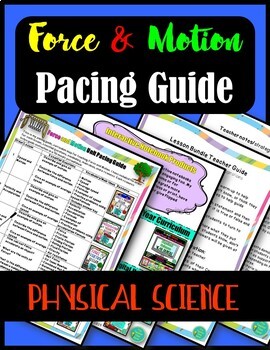
Laws of Motion Unit Curriculum Map Pacing Guide | Physical Science
This Physical Science FREE pacing guide is for the unit Laws of Motion. It outlines the following: lessons, main ideas, vocabulary, essential questions, and a resource. There is also a two-page lessons strategies handout to help support teachers who purchase my interactive notebook products. This product is part of my Force and Motion COMPLETE Unit Bundle.Force and Motion Complete Unit Bundle includes:Notebook Set-UpPre-Assessment/Warm-upLesson- Speed and MotionLesson- Acceleration and VelocityL
Subjects:
Grades:
4th - 10th
Also included in: Waves Energy & Motion- Science Interactive Notebook Unit Plan

Next Generation Science Standards (NGSS) Breakdown - MS and HS Physical Science
This free product, by It’s Not Rocket Science, is designed to help you understand the Next Generation Science Standards* for physical science – both middle school and high school. These standards, and the details behind them, have been re-organized in this product to be easier to read, understand, and implement in your classroom. I’ve read through the many pages on the website and re-arranged the content in a way that I’ve found to be more teacher-friendly for using in my classroom – and I ho
Subjects:
Grades:
Not Grade Specific
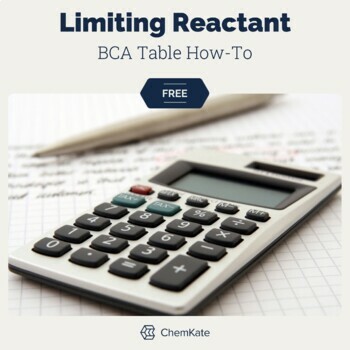
Free: Limiting and Excess Reactants/Reagents: BCA Table How To
Looking for a limiting reactant game-changer for your chemistry students? BCA Tables organize complex limiting and excess reactant problems by emphasizing the role of the mole ratio and time during a chemical reaction. This easy-to-follow BCA Table handout leads students through the steps behind BCA Tables. Complete with a YouTube video explanation. Excellent preparation for future titration and ICE table problems.See accompanying YouTube video for worksheet explained in action – great for stude
Subjects:
Grades:
9th - 12th, Higher Education, Adult Education, Staff
Types:
NGSS:
HS-PS1-7
Also included in: Custom Bundle for Jackie F.
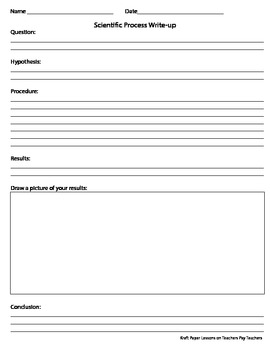
Scientific Process Write-Up For Elementary and Middle School Students
This worksheet guides elementary and middle school students through some basic steps of the scientific process. It is simple enough for them to engage in the steps, without being overwhelmed.
Students can:
State the question the experiment is asking.
Prepare a hypothesis (educated guess).
Explain the procedure they will use for their experiment.
Write about their results and draw a picture.
Tell about their conclusions based on the results of the experiment.
Subjects:
Grades:
1st - 10th

Measuring the mass, volume, and density of a student! NGSS SEP aligned
Measuring the mass, volume, and density of a student! NGSS SEP alignedThis activity is highly engaging and one that students will remember for many years. Students (who choose) will have their volume measured by water displacement, their mass measured, and, using these measurements, their density calculated. Mass and volume are reviewed in this lesson, and the formula of density is “discovered” by students with a simple activity. Instructions for construction of the giant overflow container are
Subjects:
Grades:
5th - 9th

2nd Grade Science Scope and Sequence TEKS alignment with Lesson Planning
Looking for a list of 2nd Grade Science units with standards (TEKS) to plan your whole school year?A scope and sequence is a powerful tool that helps you plan and provide engaging and effective instruction so your students can master the standards. This file is filled with clickable links providing you with examples of lessons for each standard. This is the perfect addition to use with the complete lesson sets in my store!Click the green star by my store name to follow me so you can seewhen I ad
Subjects:
Grades:
2nd

Free editable rubric and teacher manual for differentiated choice boards
Free manual and rubric for our NGSS science choice boards. Explore our versatile Choice Board Resource for grades 6,7 & 8. each is Packed with 9 different outcome activities following stated learning objectives. each resource includes as well a Reflection and feedback space including:Overall ExperienceEngagement and InterestLearning and UnderstandingLevel of ChallengeChoice and AutonomyReflection and Feedbackeach choice board is based on the NGSS learning objectives it falls under!Thank you
Subjects:
Grades:
6th - 8th
Types:
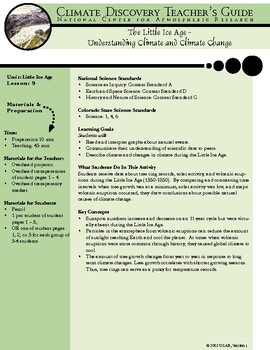
The Little Ice Age - Understanding Climate and Climate Change #9
Free LessonWhat Students DoStudents receive data about tree ring records, solar activity, and volcanic eruptions during the Little Ice Age (1350-1850). By comparing and contrasting time intervals when tree growth was at a minimum, solar activity was low, and major volcanic eruptions occurred, they draw conclusions about possible naturalcauses of climate change.
Grades:
6th - 9th
NGSS:
HS-ESS3-5
, HS-ESS3-6
, HS-ESS2-2
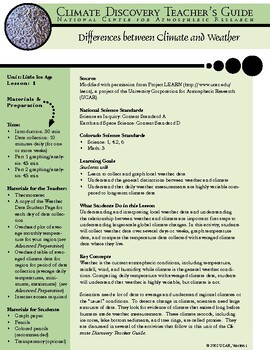
Difference Between Climate and Weather #1
FREE LESSONWhat Students Do in this LessonUnderstanding and interpreting local weather data and understanding the relationship between weather and climate are important first steps to understanding larger-scale global climate changes. In this activity, students will collect weather data over several days or weeks, graph temperature data, and compare the temperature data collected with averaged climate data where they live.
Subjects:
Grades:
6th - 8th
NGSS:
MS-ESS2-6
, MS-ESS2-5

Living During the Little Ice Age #3
Free LessonWhat Students Do in this LessonStudents brainstorm what the living conditions during the period known as the Little Ice Age (1350-1850) might have been like. Then students study information about lifestyles, the economy, crop yields, and human and livestock mortality during the Little Ice Age. They compare, and discuss what they have learned.
Subjects:
Grades:
6th - 9th
NGSS:
MS-ESS3-5
, MS-ESS3-3
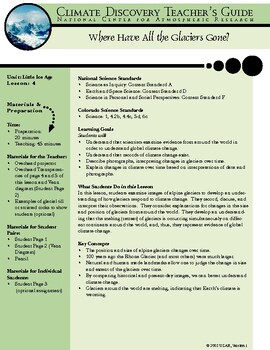
Where Have All the Glaciers Gone? #4
Free LessonWhat Students Do in this LessonIn this lesson, students examine images of alpine glaciers to develop an understanding of how glaciers respond to climate change. They record, discuss, and interpret their observations. They consider explanations for changes in the size and position of glaciers from around the world. They develop an understanding that the melting (retreat) of glaciers is occurring simultaneously on different continents around the world, and, thus, they represent evidence
Grades:
6th - 9th
NGSS:
MS-ESS2-2
, MS-ESS2-4
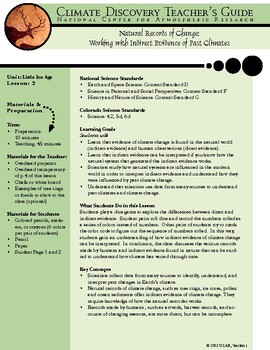
Natural Records of Change: Working with Indirect Evidence of Past Climates #2
Free LessonWhat Students Do in this LessonStudents play a dice game to explore the differences between direct and indirect evidence. Student pairs roll dice and record the numbers rolled as a series of colors instead of numbers. Other pairs of students try to crack the color code to figure out the sequence of numbers rolled. In this way, students gain an understanding of how indirect evidence of climate change can be interpreted. In conclusion, the class discusses the various records made by hum
Grades:
6th - 9th
NGSS:
HS-ESS3-6
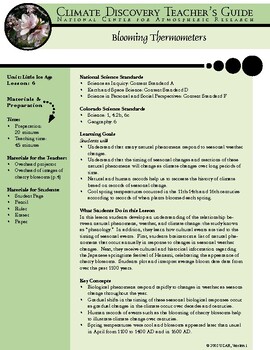
Blooming Thermometers #6
Free LessonWhat Students Do in this LessonIn this lesson students develop an understanding of the relationship between natural phenomena, weather, and climate change: the study known as “phenology.” In addition, they learn how cultural events are tied to the timing of seasonal events. First, students brainstorm a list of natural phenomena that occur annually in response to changes in seasonal weather changes. Next, they receive cultural and historical information regarding the Japanese springtim
Grades:
6th - 9th
NGSS:
MS-ESS3-5
, MS-ESS3-3
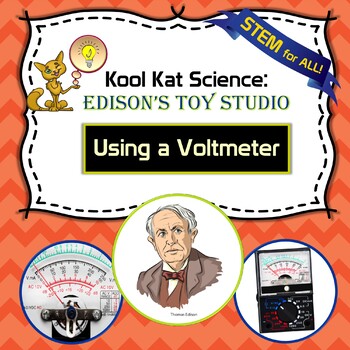
How to use a Voltmeter
Are you planning an electricity design challenge? The voltmeter is a vital tool for the IMPROVE step of the Engineering Design Process and gives students a glimpse into specialized technology used by electrical technicians. Students can use a voltmeter to check continuity, test batteries, and measure resistance (ohms). Are you looking for a fun electricity design challenge lesson? This sample comes from the Kool Kat Science Electric Circuit Design Challenge. Give your students a solid understan
Subjects:
Grades:
3rd - 6th
Types:

Usborne Science Encyclopedia 2015 Supplemental Workbook
The sample includes the workbook questions for the first 5 lessons in the Usborne Science Encyclopedia 2015.
Subjects:
Grades:
7th - 8th
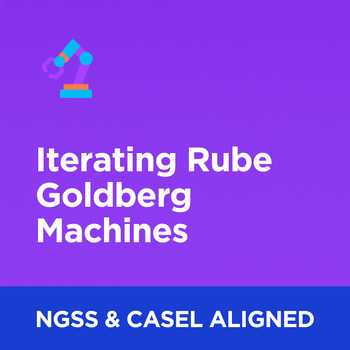
Iterating Rube Goldberg Machines
Topic: Physical Science and EngineeringDesign, build and refine Rube Goldberg Machines to convert mechanical energy into sound energy and practice the skill set of iteration. Students will use a computer simulation to explore the idea, learn associated vocabulary and then construct a device using common materials. They will finally explain how energy is converted in their device.
Subjects:
Grades:
6th - 12th
Types:
NGSS:
HS-PS3-3
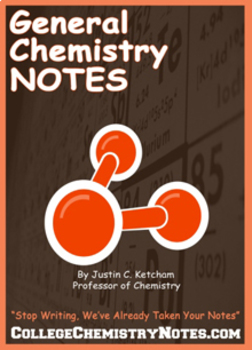
General Chemistry Section 2 - Atoms, Molecules, and Ions (free)
** It's best to visit us on the web at Chemistry Notes---------General Chemistry Lecture Notes -- for a typical second chapter ("section") of a high school chemistry course (AP, honors, regular) -or- college-level general chemistry course.Excellent for instructors who like to write out their lecture notes on the board "as they teach"...SECTION 2 - ATOMS, MOLECULES, AND IONS2-1 -- Three Fundamental Chemical Laws· The Law of Conservation of Mass· The Law of Definite Proportions· The Law of Multipl
Subjects:
Grades:
10th - 12th, Higher Education
Types:
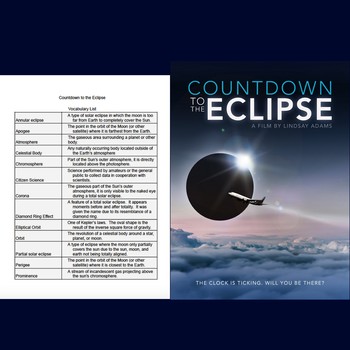
Countdown to the Eclipse Documentary Vocabulary List Pre or Post Movie
Get ready for the Total Solar Eclipse with a free eclipse documentary! Available on Amazon, Countdown to the Eclipse, prepares students for the upcoming eclipse using NASA animations and immersing the viewer into the journey of a group of eclipse chasers as they chase after the 2016 total solar eclipse. Appropriate for all ages.
https://www.amazon.com/dp/B0747D3HHW/ref=sr_1_1?ie=UTF8&qid=1501015528&sr=8-1&keywords=countdown+to+the+eclipse
Runtime is 44 minutes. Closed captioned.
Subjects:
Grades:
5th - 12th
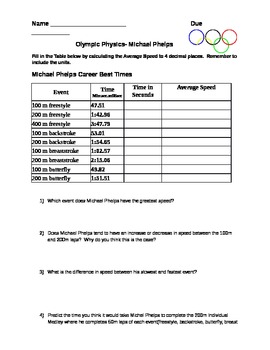
Olympics Physics Activity based on Michael Phelps
This activity or project is a follow up to watching a Michael Phelps Race to enage students with a real world physics problem. This activity uses calculations to determine average speed, analyze data from different races, predict and calculate his performance in the individual medley, and compare predicted to actual results. My students found this a much more interesting problem than the typical rolling a car or ball down a ramp. I hope you will find it useful in your class!
Subjects:
Grades:
6th - 11th
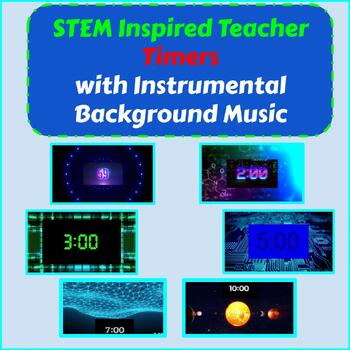
Free Classroom Timers (STEM Inspired), Teacher Timers, Classroom Countdown
Here are free STEM Inspired classroom timers! They have instrumental background music. And no loud bell at the end, instead there is a soft beep noise to let you know time is up. Offered Timers: 1 minute, 2 minute, 3 minute, 5 minute, 7 minute, and 10 minute.
Subjects:
Grades:
Not Grade Specific
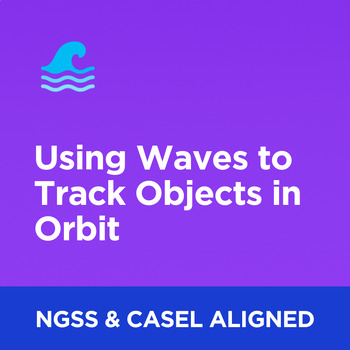
Using Waves to Track Objects in Orbit
Topic: Physics/Physical ScienceStudents will communicate how reflecting telescopes use waves to track objects.
Subjects:
Grades:
6th - 12th
NGSS:
HS-PS4-5

FORCE... Field Day
6 activity based lessons on forces and practical application. All lessons lead up to a Balloon Car engineering project. Includes vocabulary sheet/matching activity and answer key.
Subjects:
Grades:
2nd - 5th
NGSS:
K-2-ETS1-2
, K-2-ETS1-3
, K-2-ETS1-1
, 3-PS2-1
, 3-5-ETS1-3
...

SNC1W Data Gathering Framework | Grade 9 Science
SNC1W teachers looking for equitable grading practice, this data gathering framework is for you. Using the Ontario curriculum expectations and based on the research from "Building Thinking Classrooms" by Peter Liljedahl, and "Grading for Equity" by Joe Feldman, this standards-based grading method will meet the intention of the Grade 9 De-Streamed Science course. The framework outlines how I am evaluating my SNC1W students in the STEM Skills unit, along with the units of Chemistry, Ecosystems (Bi
Subjects:
Grades:
9th, Staff
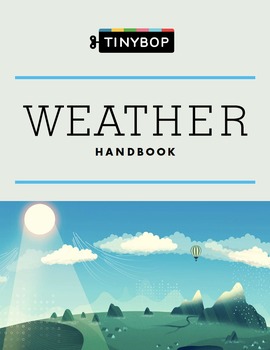
Weather Bundle & Educator Guide
All the tools you need to complete your own Weather unit in your classroom!
Bundle Includes:
+ The Weather Journal
+ 18-page Weather Handbook
+ Educator's Guide
Support your students’ learning with our handbooks: they’re full of interaction hints, discussion questions and insider intelligence.
Organize your lesson planning with our one sheet guide for educators! Select key concepts, vocabulary, and learning outcomes to plan your instruction and use of the Weather app in your classroom!
Copy
Grades:
3rd - 8th
Types:
Showing 1-24 of 71 results





